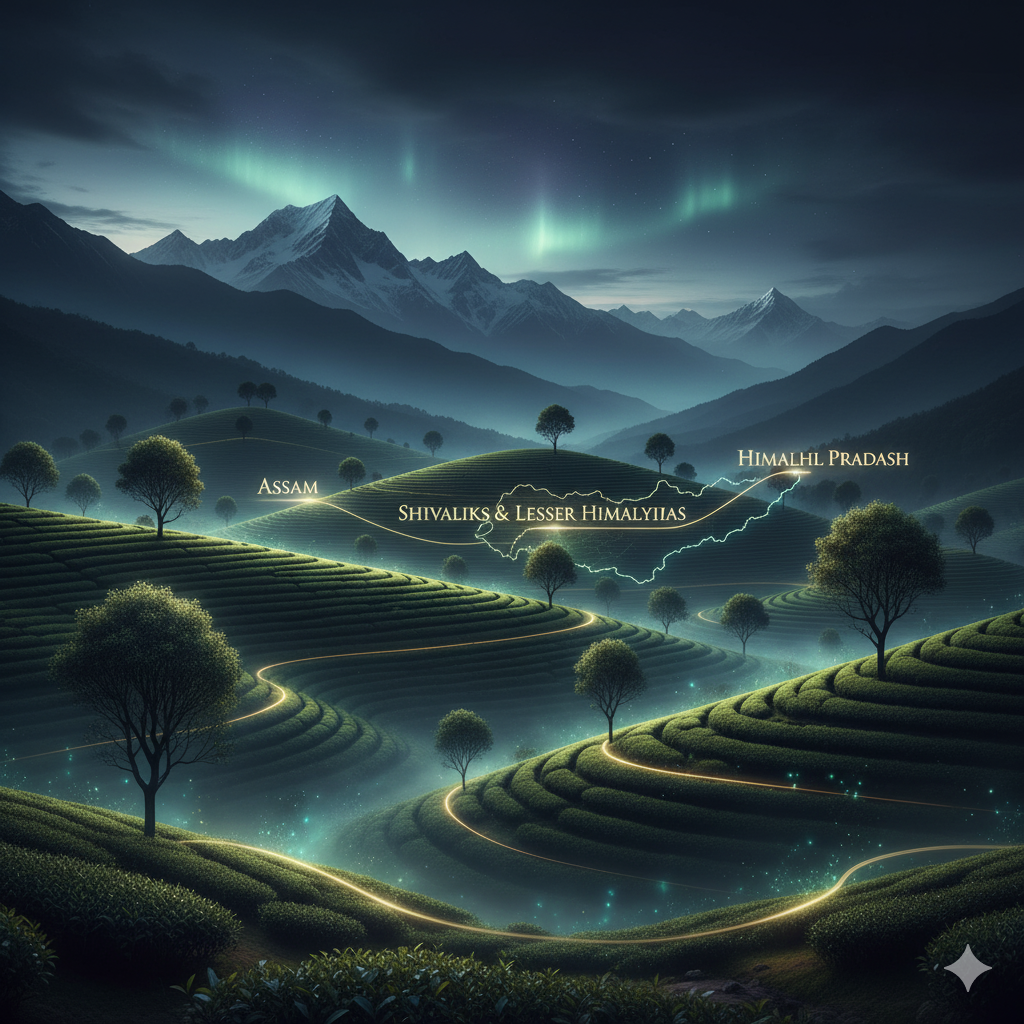Introduction
Tea cultivation has been an integral part of India’s colonial agricultural history. Introduced and popularized by the British during the 19th century, tea plantations transformed the socio-economic and ecological landscape of the Himalayan foothills.
The Shivaliks and Lesser Himalaya, stretching from Assam in the east to Himachal Pradesh in the northwest, were initially targeted by British planters for commercial tea cultivation. Despite efforts to establish plantations across this vast belt, commercial success was largely confined to the Darjeeling area. Understanding this pattern requires an analysis of climatic, topographic, soil, economic, and historical factors.
This essay critically examines the geographical and socio-economic reasons behind the British focus on Darjeeling and the limitations faced elsewhere in the Shivaliks and Lesser Himalaya.
Tea Cultivation in Colonial India: An Overview
- Historical Background
- Tea was introduced to India in the early 19th century by the British East India Company to break China’s monopoly on tea.
- Assam Tea: Discovered in Assam in 1823 by Robert Bruce; quickly became a major export commodity.
- Darjeeling Tea: Introduced around the 1840s; gained fame for its unique aroma and flavor, attributed to Himalayan climatic conditions.
- British Planter Objectives
- Establish large-scale, profitable plantations to meet growing global demand.
- Exploit regions with favorable climatic conditions similar to Chinese tea-growing areas.
- Utilize cheap local labor and expand the colonial agrarian economy.
Geographic Spread: Shivaliks and Lesser Himalaya
- Shivaliks
- Located at the southern edge of the Himalayas, forming a narrow, low-elevation belt.
- Composed of sandy and conglomerate soils, highly prone to erosion.
- Elevation: 300–1,500 meters.
- Lesser Himalaya
- Runs parallel to the Shivaliks, includes Himachal Pradesh, Uttarakhand, and northern West Bengal.
- Elevation: 1,500–3,000 meters.
- Composed of metamorphic and igneous rocks, forming more stable slopes.
- Target Regions
- British planters surveyed areas from Assam (eastern India) to Himachal Pradesh (northwest India).
- Darjeeling, in north Bengal, emerged as a prime candidate due to unique climatic and topographic conditions.
Climatic Requirements for Tea Cultivation
Tea (Camellia sinensis) requires specific climatic conditions:
- Temperature
- Optimal range: 10°C–30°C.
- Frost-free conditions are crucial; young plants are highly sensitive to cold.
- Rainfall
- Annual rainfall: 1,200–3,000 mm, well-distributed.
- Adequate rainfall prevents water stress and ensures quality leaf production.
- Humidity and Cloud Cover
- High humidity and consistent cloud cover improve tea aroma.
- Shade reduces stress on leaves, enhancing biochemical compounds.
- Altitude
- High-altitude tea (>1,500 meters) develops finer flavor, smaller leaves, and aromatic qualities.
Soil Requirements
- Darjeeling Advantage
- Well-drained loamy soils rich in organic matter.
- Slightly acidic (pH 4.5–5.5), ideal for Camellia sinensis var. sinensis.
- Slopes prevent waterlogging, reducing root diseases.
- Limitations in Other Regions
- Shivaliks: Sandy, erosion-prone soils with low water retention.
- Himachal Pradesh valleys: Rocky, shallow soils; require extensive terracing.
- Uttarakhand: Soil fertility variable; limited flat terrain for large plantations.
Topographic Factors
- Darjeeling Hills
- Altitude: 600–2,000 meters, gentle to moderate slopes.
- Provides natural drainage, minimizing stagnation and root rot.
- Foggy conditions improve tea aroma.
- Shivaliks and Lesser Himalaya Elsewhere
- Shivaliks: Low elevation, prone to high temperatures in summer, unsuitable for high-quality tea.
- Steep slopes in Himachal: Difficult mechanization, soil erosion, and labor challenges.
- Valley bottoms: Waterlogging, poor drainage.
Socio-Economic and Labor Considerations
- Labor Availability
- Darjeeling: British imported Nepali laborers, skilled in hillside cultivation.
- Shivaliks: Sparse local population; agricultural labor largely unorganized.
- Market Access and Transportation
- Darjeeling: Proximity to Siliguri plains and port access for exports.
- Other Shivalik regions: Limited road and rail connectivity; high transport costs reduced profitability.
- Colonial Incentives
- British invested heavily in infrastructure, irrigation, and estate development in Darjeeling.
- Elsewhere, lack of incentives and higher operational costs discouraged large-scale plantation development.
Challenges in Expanding Beyond Darjeeling
- Climatic Constraints
- Eastern Himachal and Uttarakhand: Cold winters with occasional frost damaging young plants.
- Shivaliks: Hot summers, insufficient altitude for aromatic tea.
- Topographic Limitations
- Terracing required on steep slopes increased labor and capital costs.
- Erosion-prone soils in Shivaliks made plantation sustainability challenging.
- Soil Fertility and Water Management
- Darjeeling’s loamy, well-drained soils superior to rocky and sandy soils elsewhere.
- Irrigation challenges in remote Shivalik and Lesser Himalayan areas.
- Economic Viability
- High production costs in Himachal and Uttarakhand due to labor, terracing, and transport.
- Darjeeling’s unique flavor commanded premium prices, ensuring economic sustainability.
- Pest and Disease Incidence
- Hotter, humid Shivalik regions prone to leaf blight and fungal diseases.
- Darjeeling’s cooler climate reduced pest pressure.
Historical Context: Darjeeling’s Success
- Charles Alexander Bruce (1835–1837)
- Experimented with Assam tea plants in Darjeeling.
- Found Darjeeling’s climate and soil superior to other Shivalik regions for commercial tea.
- Introduction of Chinese Tea Varieties
- Darjeeling: Camellia sinensis var. sinensis from China thrived at high altitudes.
- Produced fine-leaf, aromatic tea distinct from Assam tea.
- Estate System and Colonial Support
- British developed tea gardens with proper drainage, irrigation, and labor systems.
- Export-oriented model ensured profitability.
Ecological and Environmental Factors
- Darjeeling
- Moderate slopes: Reduced soil erosion.
- Persistent cloud cover: Maintained humidity for tea growth.
- Forested areas: Provided shade and organic matter.
- Other Himalayan Regions
- Steep slopes: Higher landslides risk.
- Deforestation for plantation establishment caused soil degradation.
- Unstable microclimates affected tea quality.
Lessons from Other Attempts
- Himachal Pradesh
- Initial plantations in Kangra and Mandi faced frost damage and poor soil fertility.
- Some success in Kangra valley, but quality inferior to Darjeeling.
- Uttarakhand
- Attempts in Almora and Tehri plateau hindered by poor transport, harsh winters, and steep slopes.
- Assam Plains
- Successfully cultivated low-altitude, high-yield tea, but flavor and aroma different from Darjeeling tea.
Socio-Economic Impact of Darjeeling Tea
- Employment Generation
- Tea estates employed thousands of Nepali and local workers.
- Export Earnings
- Darjeeling tea gained global recognition, contributing to colonial revenue.
- Cultural Landscape
- Creation of hill settlements, labor colonies, and estate infrastructure shaped the Himalayan foothills.
- Tourism and Branding
- Darjeeling’s tea gardens became tourist attractions, reinforcing economic sustainability.
Conclusion
While the British aimed to expand tea plantations across the Shivaliks and Lesser Himalaya, their success was largely confined to Darjeeling due to a combination of favorable climatic, soil, topographic, and socio-economic factors.
- Climatic Superiority: Moderate temperatures, high rainfall, and persistent cloud cover.
- Soil Advantage: Loamy, well-drained, slightly acidic soils ideal for aromatic tea.
- Topography: Gentle slopes facilitated plantation establishment and reduced erosion.
- Labor and Infrastructure: Ready availability of skilled labor, better transport, and colonial investment.
- Economic Viability: Premium pricing of Darjeeling tea ensured profitability despite high costs.
Elsewhere in the Shivaliks and Lesser Himalaya, climatic extremes, poor soil, rugged terrain, limited labor, and high operational costs hindered sustainable plantation development.
In essence, Darjeeling emerged as the quintessential hill tea region, demonstrating the critical interplay of geography, climate, economy, and colonial policy in shaping India’s tea industry.




